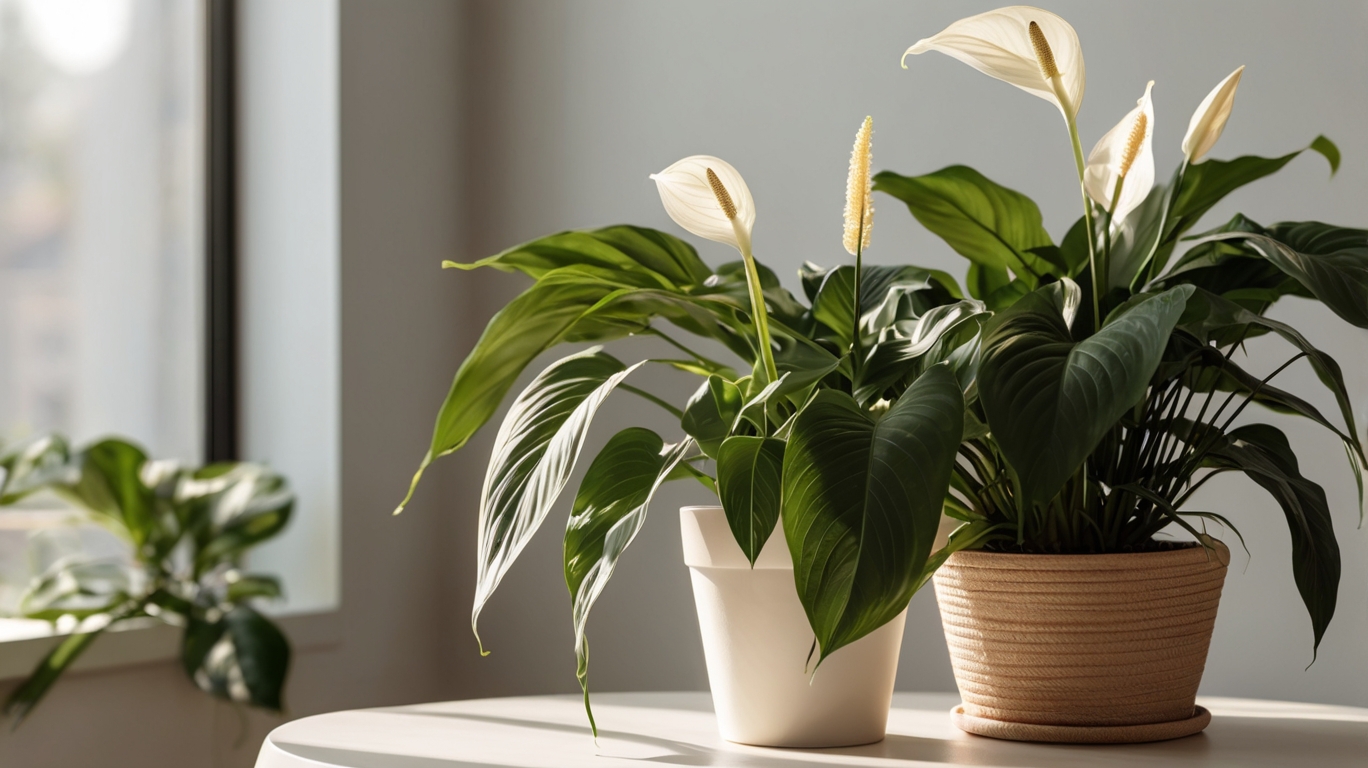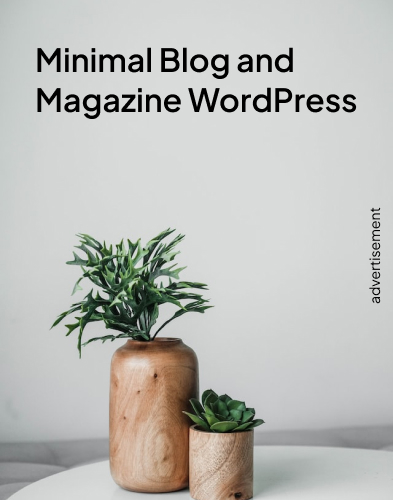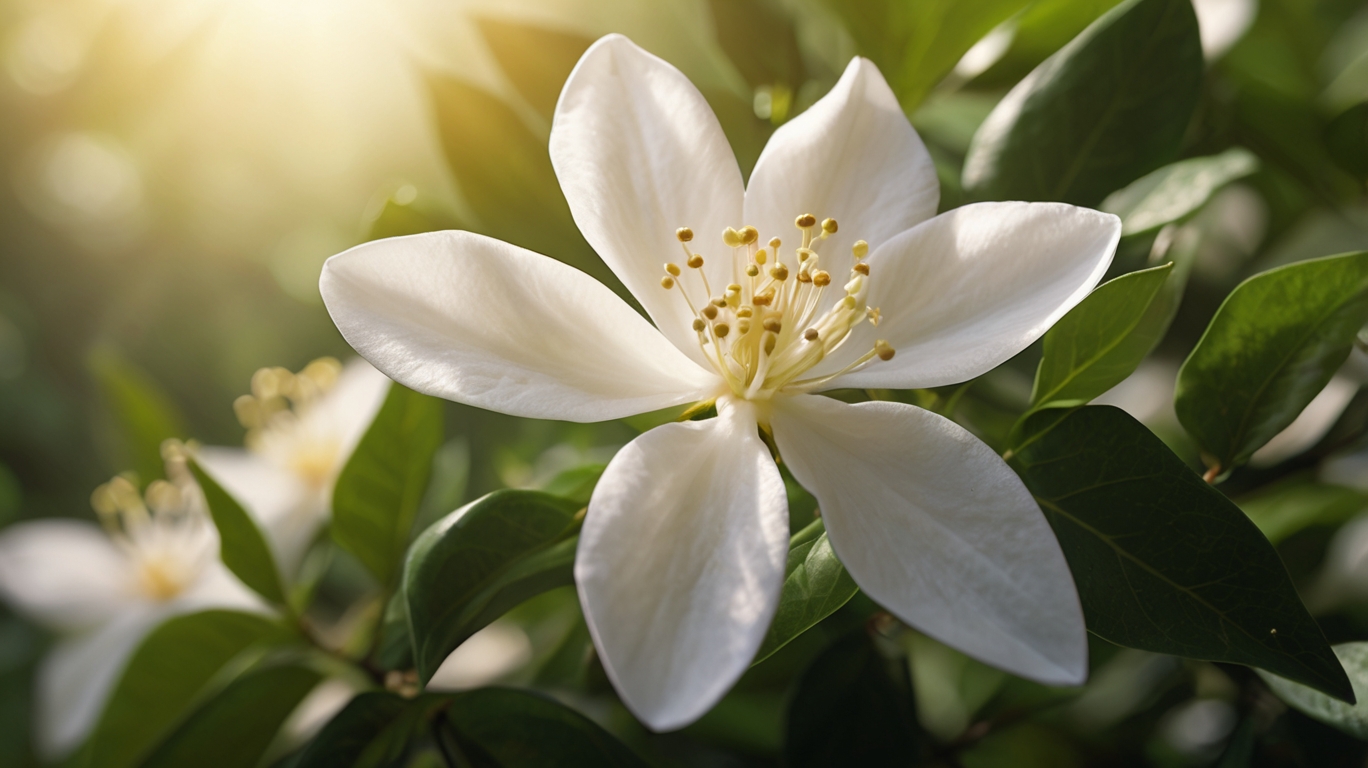“Dogs and Jasmine Flowers: The #1 Ultimate Guide to Keeping Your Pup Safe”

Introduction: The Importance of Understanding Plant Toxicity for Dogs
Dogs, like humans, interact constantly with their environment, which often includes various plants found in homes, yards, or parks. While many plants pose little to no risk, some can be harmful or even deadly to canine companions if ingested or touched. Understanding plant toxicity is essential for pet owners because dogs often explore the world through their noses and mouths, making them more susceptible to accidental exposure to potentially toxic substances.
When a dog comes into contact with a toxic plant, symptoms can vary widely based on the plant species, the dog’s size, and the amount ingested. Reactions may range from mild gastrointestinal discomfort to severe organ failure. Awareness of these risks can prevent exposure and ensure a safer living environment. It is a pet owner’s responsibility to be knowledgeable about both common and rare plants that dogs might encounter, especially those frequently found in gardens, landscapes, and decorative arrangements.
Proactive measures, such as researching plant safety before introducing them to immediate surroundings, are crucial. Pet owners need to familiarize themselves with signs of plant poisoning, including vomiting, diarrhea, lethargy, drooling, and difficulty breathing. Prompt action in such situations can be life-saving, emphasizing the importance of recognizing symptoms and seeking veterinary assistance promptly.
Several factors exacerbate the risks associated with plant toxicity. Puppies, for instance, are often more curious and prone to chewing unfamiliar objects, putting them at greater risk. Similarly, indoor plants and outdoor vegetation can be easy targets for unsupervised dogs. By understanding plant toxicity, dog owners can adopt preventative strategies that reduce the likelihood of such incidents, ensuring the health and well-being of their pets.
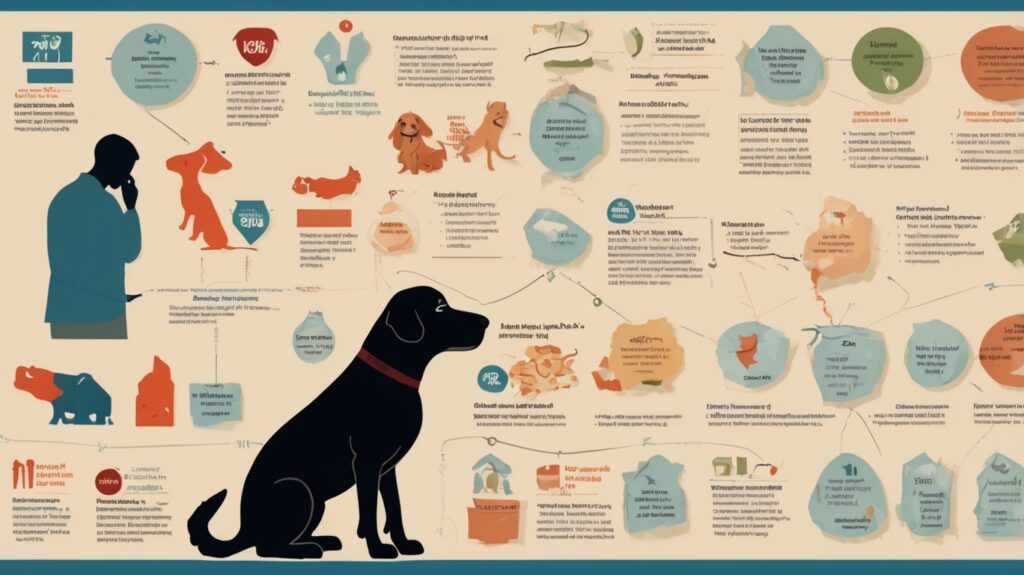
What Is Jasmine Flower? A Quick Overview
Jasmine flowers are renowned for their delicate beauty and intensely fragrant blossoms, making them a favorite in gardens, floral arrangements, and aromatherapy. This plant belongs to the genus Jasminum, which is part of the Oleaceae (olive) family. Originating primarily from tropical and subtropical regions, jasmine is native to areas in Asia, Africa, and the Mediterranean, but it has spread widely in cultivation due to its ornamental appeal.
Recognized by their star-shaped blooms, jasmine flowers typically showcase colors ranging from pure white to pale yellow, depending on the species. Some varieties carry an exquisite, sweet scent, while others may be unscented. They grow either as shrubs or twining vines, lending versatility to their use in landscapes or as decorative accent plants indoors.
Jasmine thrives in warm climates, preferring well-drained soil and plenty of sunlight. Its flowers often bloom during summer and carry cultural significance in countries like India and the Philippines, symbolizing purity, love, and spiritual connection. Beyond its aesthetic appeal, jasmine is widely used in products such as teas, essential oils, perfumes, and skincare due to its unique aroma and purported health benefits.
There are many species under the jasmine category, including Jasminum officinale (common jasmine) and Jasminum sambac (Arabian jasmine), with each species holding distinctive traits. However, it’s worth noting that not every plant called “jasmine” belongs to the same genus. For instance, plants like Carolina jasmine (Gelsemium sempervirens) and Cape jasmine (Gardenia jasminoides) use the name but are biologically unrelated.
Understanding the differences between true jasmine and other similarly named plants is crucial, especially when discussing potential toxicity and safety related to pets like dogs.
Common Types of Jasmine and Their Characteristics
Jasmine is a versatile and fragrant plant sought after for its beauty and aromatic qualities. However, not all plants with “jasmine” in their name are true jasmine species. Below are some of the common types of jasmine and their characteristics:
1. Common Jasmine (Jasminum officinale)
- Also known as poet’s jasmine, this is one of the most widely recognized species.
- Features delicate, star-shaped white flowers with a sweet, intense fragrance.
- It is a climbing plant that can grow up to 30 feet when supported by structures like trellises.
- Common jasmine blooms from late spring to summer, thriving in well-drained soil and full sun.
2. Arabian Jasmine (Jasminum sambac)
- Known for its smaller, pinwheel-like blossoms that produce a powerful and intoxicating scent.
- Found in tropical and subtropical regions, including India and Southeast Asia.
- This species is popular in making garlands, teas, and perfumes due to its aromatic petals.
- Arabian jasmine typically takes a more shrub-like form rather than a climbing habit.
3. Winter Jasmine (Jasminum nudiflorum)
- Unique for its bright yellow, non-fragrant flowers that bloom in late winter or early spring.
- Distinguished by its ability to thrive in colder climates and sporadic flowering in frost.
- Unlike other jasmine species, this shrub-like plant grows more horizontally, making it ideal for ground cover or cascading over walls.
4. Star Jasmine (Trachelospermum jasminoides)
- Despite its name, this is not a true jasmine but is often grouped due to its jasmine-like scent and blooms.
- Features small, star-shaped white flowers and glossy, evergreen leaves.
- It is a hardy climber, commonly used as ground cover or decorative hedging.
- Resistant to drought, it thrives in both full sunlight and partial shade.
5. Primrose Jasmine (Jasminum mesnyi)
- A larger type of jasmine with semi-double yellow flowers that lack fragrance.
- Blooms profusely during late winter and spring, adding a burst of color to gardens.
- It is a fast-growing shrub suited to warmer climates and prefers well-drained, fertile soil.
While these types of jasmine showcase visual and aromatic diversity, it is important to confirm whether they are toxic to pets, as certain types, such as false jasmine (Gelsemium sempervirens), can pose risks to dogs despite having “jasmine” in the name.
Are Jasmine Flowers Poisonous to Dogs?
The question of whether jasmine flowers are poisonous to dogs requires clarification, as not all plants commonly referred to as “jasmine” are the same. True jasmine species, such as Jasminum officinale (commonly known as common jasmine or poet’s jasmine), are generally considered non-toxic to dogs. However, it is crucial to confirm the specific type of jasmine present, as the name “jasmine” is often mistakenly applied to other unrelated plants that could pose toxicity risks.
A notable example of misidentification is Carolina jasmine (Gelsemium sempervirens). Despite its name, this plant is not a true jasmine and contains toxic alkaloids harmful to dogs when ingested. Signs of poisoning from Carolina jasmine can include drooling, vomiting, difficulty breathing, seizures, or even death in severe cases. This highlights the importance of identifying the exact species before assuming safety.
True jasmine flowers, in contrast, are not known to contain harmful compounds for dogs, though every animal reacts differently, especially if consumed in large quantities. Even non-toxic plants can cause mild gastrointestinal upset in dogs due to their sensitive digestive systems. Symptoms may include vomiting, diarrhea, or general discomfort.
Pet owners should also be mindful of fertilizers, pesticides, or other chemical treatments used on or near jasmine plants. These substances, rather than the plant itself, may introduce harmful elements to a dog’s system if licked or ingested.
To ensure any jasmine plant in or around the home is safe, thorough identification and cautious handling are advised. Consultation with a veterinarian or horticulture expert is recommended if uncertainty arises about a specific jasmine species or its safety for pets.
Identifying Toxic and Non-Toxic Varieties of Jasmine
Understanding the differences between toxic and non-toxic varieties of jasmine is essential, especially for dog owners who aim to keep their pets safe. While the term “jasmine” refers to several flowering plants belonging to different botanical families, not all species are safe for dogs. Some varieties can pose a risk due to their toxic properties, while others are harmless.
Non-Toxic Jasmine Species
True jasmine varieties belong to the genus Jasminum and are generally considered non-toxic to dogs. These include popular species such as:
- Common Jasmine (Jasminum officinale): Also known as poet’s jasmine, this variety features fragrant white flowers and causes no harm to dogs if ingested.
- Arabian Jasmine (Jasminum sambac): Widely used in tea and perfumes, this type is non-toxic and pet-friendly.
Members of the Jasminum genus are typically safe for pets and can be grown with peace of mind in households with dogs. However, pet owners should still monitor their dogs closely to prevent overconsumption, as excessive plant material can cause gastrointestinal upset.
Toxic Jasmine Species
The confusion often arises when unrelated plants are colloquially referred to as jasmine. Some of these species have toxic effects on dogs, and they do not belong to the Jasminum genus:
- Carolina Jasmine (Gelsemium sempervirens): Despite the resemblance in name, this plant is highly toxic to dogs. Its yellow flowers contain alkaloids that can lead to symptoms such as vomiting, seizures, or even paralysis.
- False Jasmine (Trachelospermum jasminoides): Also called star jasmine, this species contains compounds that may irritate dogs if consumed.
Key Considerations
Pet owners should verify the scientific name of jasmine plants before introducing them into their gardens or homes. Naming overlaps can lead to accidental exposure to toxic varieties, making identification crucial. When in doubt, consulting a veterinarian or plant specialist is advisable.
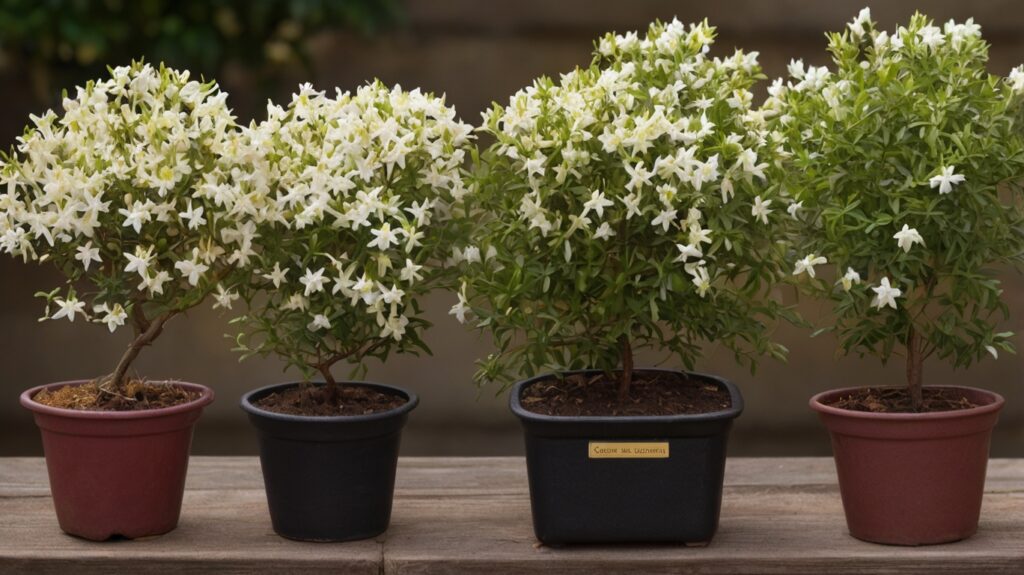
Signs and Symptoms of Plant Poisoning in Dogs
Dogs may unintentionally ingest toxic plants during outdoor exploration or by chewing on houseplants, leading to potential poisoning. Identifying signs of plant toxicity early is critical to protect their health. Symptoms can vary depending on the type and amount of plant ingested. Owners should always observe their dogs for unusual behavior or physical changes.
Physical Symptoms
- Vomiting and Diarrhea: A common reaction to plant toxicity. Dogs may expel ingested material in an attempt to rid their system of harmful substances.
- Drooling: Excessive drooling can indicate irritation in the gastrointestinal tract caused by toxic components of the plant.
- Lethargy: Dogs may exhibit extreme fatigue due to weakness and reduced energy following exposure to toxins.
- Swelling or Irritation: Swelling in the mouth, lips, tongue, or throat is often observed, especially if the plant contains irritants or sharp particles.
Behavioral Changes
- Excessive Pawing at the Mouth: Dogs might paw at their mouth if they feel discomfort or pain after eating the plant.
- Loss of Appetite: Poisonous plant consumption often results in a lack of interest in food due to gastrointestinal distress.
- Restlessness or Agitation: Dogs may display heightened anxiety or behavioral changes resulting from pain or toxicity effects.
Severe Reactions
While mild poisoning may result in digestive upset, severe reactions can occur in cases of significant exposure. Extreme symptoms include:
- Seizures: Neurological damage resulting from toxins in certain plants may lead to tremors or seizures.
- Breathing Difficulties: Respiratory distress may occur due to swelling or internal damage caused by toxic compounds.
- Organ Failure: Certain toxins can affect vital organs such as the liver, kidneys, or heart, leading to life-threatening complications.
Instances of plant poisoning, regardless of severity, require immediate veterinary attention to ensure proper care and treatment.
What to Do If Your Dog Eats a Jasmine Flower
If a dog consumes jasmine flowers, it is important to act cautiously to ensure their well-being. While some types of jasmine plants are non-toxic, others, like “false jasmine” or Carolina jessamine (Gelsemium sempervirens), are known to be poisonous to dogs. Take immediate action to determine the variety of jasmine involved and assess the potential risk to the dog’s health.
1. Identify the Jasmine Plant
The first step is identifying the specific jasmine plant consumed. True jasmine species from the Jasminum genus are generally safe for dogs. However, other plants resembling jasmine, particularly the Carolina jessamine, can be toxic due to alkaloid compounds in the flowers, stems, and leaves. If the type of jasmine consumed cannot be easily identified, take a photograph of the plant and consult a veterinarian or horticulturist to confirm its toxicity status.
2. Check for Symptoms
Monitor the dog closely for signs of poisoning or gastrointestinal distress. Toxic plants may cause symptoms such as vomiting, diarrhea, drooling, weakness, confusion, or tremors. If the dog exhibits any of these symptoms, medical attention should be sought immediately. Even in cases where the jasmine flower is not toxic, an upset stomach may occur due to ingesting foreign matter.
3. Call a Veterinarian
Contacting a veterinarian is essential, particularly if your dog has ingested a plant with potential toxicity. Provide information on the type of jasmine consumed and any symptoms observed. The veterinarian may recommend bringing the dog in for examination or advise on administering first aid at home, such as offering water to dilute the substances ingested. Experts may also use activated charcoal to absorb toxins in the digestive tract, if applicable.
4. Prevent Further Ingestion
Ensure the safety of the dog by removing any accessible jasmine plants or securing areas where the plant grows. Early prevention methods can mitigate risks and help avoid repeated instances of ingestion. Educating family members about plant safety and dog-proofing the yard also contributes to minimizing accidents.
5. Stay Calm and Follow Professional Advice
Remaining calm is crucial when dealing with a potential poisoning incident. Dogs often feed off their owner’s energy, and a calm demeanor can help keep them more settled during an emergency. Strictly adhering to the veterinarian’s instructions ensures prompt and effective handling of the situation while preventing further complications.
Taking proactive measures after your dog eats jasmine flowers, paired with professional guidance, can safeguard their health and prevent future issues. Always prioritize consulting an expert over attempting DIY treatments for accidental plant ingestion.
Preventative Measures to Keep Your Dog Safe
When it comes to protecting dogs from potential harm caused by jasmine flowers or any toxic plants, prevention is key. While not all jasmine species are toxic to dogs, it is important for dog owners to ensure their pets avoid unnecessary exposure to plants whose safety may be uncertain.
Ensure Proper Identification of Plants
Dog owners should familiarize themselves with the types of jasmine plants present in their homes, gardens, or nearby environments. Jasmine varieties such as true jasmine (Jasminum species) are generally non-toxic, while species like Carolina jasmine (Gelsemium sempervirens) are poisonous. If the identification is unclear, consulting with a botanist, horticulturist, or veterinarian can help confirm whether a particular plant is safe.
Supervise Dogs Outdoors
To prevent unwanted interactions with risky plants, owners should monitor dogs when outside. Ensuring dogs play in controlled environments without easy access to unfamiliar plants can minimize contact with potentially harmful vegetation. Fenced spaces and designated dog-friendly areas are excellent options.
Use Physical Barriers
If potentially toxic jasmine plants are present near the property, physical barriers such as garden fences or netting can deter dogs from approaching or ingesting leaves, stems, or flowers. Keeping poisonous plants out of reach is a simple yet effective preventative measure.
Remove Hazardous Plants
Removing toxic jasmine species, like Carolina jasmine, from your surroundings is one of the most straightforward ways to safeguard pets. This elimination prevents accidental ingestion and eliminates the possibility of allergic reactions or poisoning.
Educate Family and Visitors
Discussing plant toxicity with family members and visitors allows everyone to participate in keeping the household safe for pets. Shared knowledge ensures vigilance and minimizes the risk of accidental exposure.
Provide Alternatives
Offer dogs safe and appropriate chew toys or treats to reduce their curiosity toward plants. This helps redirect their attention and satisfies their exploratory instincts in a safe manner.
Taking these preventative steps contributes significantly to maintaining a dog’s safety and well-being while fostering a harmonious environment. Always consult a veterinarian if accidental exposure occurs or if symptoms of poisoning are observed.
Safe Alternatives to Jasmine for a Dog-Friendly Garden
Garden enthusiasts who want to prioritize their dog’s safety while maintaining a beautiful landscape can consider a variety of non-toxic plants. These alternatives are dog-friendly and provide visual appeal without posing health risks. Choosing suitable plants helps create a harmonious environment where pets can roam freely without concern.
Dog-Safe Flowering Plants
Many flowering plants add bursts of color to gardens and are safe for dogs. Options include:
- Marigolds: Known for their golden hues, marigolds are non-toxic to dogs while deterring pests.
- Snapdragons: These vibrant flowers come in numerous colors and are harmless to pets.
- Roses: Provided that they are thorn-free or properly maintained, roses are safe and fragrant additions to the garden.
- Sunflowers: With their iconic yellow blooms, sunflowers are safe for dogs and require minimal care.
Foliage and Ground Cover
If flowers are not the primary focus, consider greenery that supports a pet-friendly space. These options include:
- Irish Moss: A soft, low-maintenance ground cover ideal for foot traffic from both pets and humans.
- Areca Palm: A tropical-looking plant that adds height without compromising safety for dogs.
- Bamboo Palm: Safe for dogs and excellent for creating shaded zones.
Herbs for Functionality and Safety
Adding herbs to a dog-friendly garden allows for practical use in cooking while ensuring pets remain unharmed. Recommended herbs include:
- Thyme: Hardy and aromatic, thyme is a versatile and safe ground cover.
- Basil: Adds lush greenery and works well in both garden beds and containers.
- Parsley: A robust herb that flourishes in most conditions without posing any risk to dogs.
By incorporating these alternatives into landscaping plans, gardeners can enjoy both aesthetic beauty and peace of mind in protecting their canine companions.
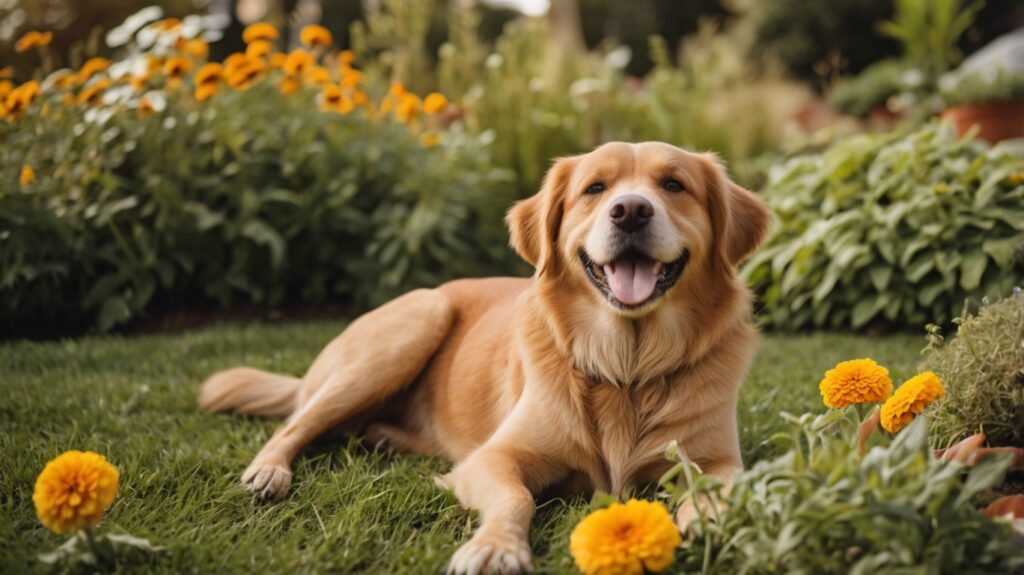
Conclusion: Ensuring Your Pet’s Well-being Around Plants
Creating a safe environment for pets requires attention to every detail, including the types of plants they may encounter. Dogs, driven by their natural curiosity, may sniff, paw at, or even chew on flowers and greenery—activities that could lead to unexpected health risks. Owners can take proactive measures to ensure their furry companions are shielded from potential hazards posed by plants, whether indoors or outdoors.
Steps to Protect Dogs from Harmful Plants
- Identify Toxic Plants: Begin by researching and identifying plants that may pose risks to dogs. Certain plants, like some varieties of jasmine, though not inherently toxic, may still cause mild irritation or stomach upset for sensitive animals.
- Provide Supervision: Especially in outdoor environments, dogs should be supervised to prevent contact with unknown or potentially dangerous plants.
- Create Boundaries: Use garden fences, planters, or dedicated pet-free zones to restrict access to questionable vegetation.
- Educate Yourself: Understanding the specific risks of common plants helps owners make informed decisions about landscaping and houseplant choices.
Alternatives and Safer Species
Pet-friendly plants, such as spider plants, are ideal for dog-friendly households. When selecting greenery for indoor decoration or outdoor gardens, it’s advisable to opt for non-toxic varieties, which ensure peace of mind and promote harmony between pet ownership and horticulture.
Monitoring Symptoms
Should a dog exhibit unusual symptoms after contact with flowers or plants—including vomiting, diarrhea, or excessive drooling—consulting a veterinarian promptly is crucial. Professionals can help determine the source of distress and suggest appropriate care.
Building Safer Habits
Building awareness around plants’ impact on canine health fosters stronger bonds between pets and their owners. Responsible pet care includes regular inspections, appropriate plant selection, and prompt reactions to unusual behavior—all aimed at safeguarding the well-being of beloved companions.




